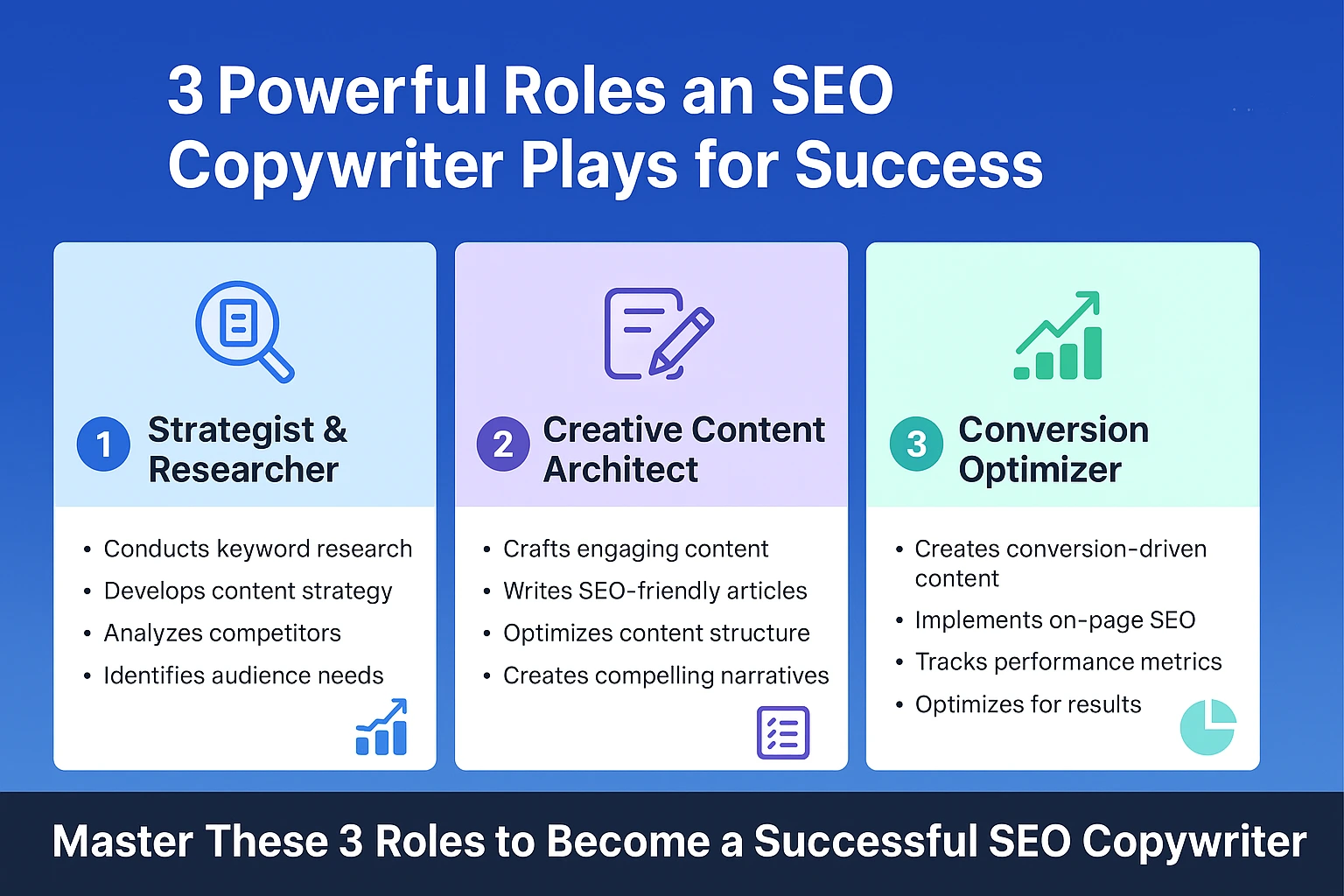Check out
Master Content Writing in 7 Proven Steps!An SEO copywriter helps companies get past the annoying problem of producing content that ranks well but doesn’t captivate readers by serving as a link between technical optimisation and creative storytelling. Many businesses struggle with content that sounds lovely or reads like it was written by a robot, but never shows up in search results, making it impossible for their target audience to find the answers they so desperately need.

Professionals with multifaceted skills who can combine writing SEO content with action-oriented messaging are in high demand in the digital world. Few content creators are able to strike the ideal balance between satisfying search engine optimisation algorithms and human emotions, which is what SEO copywriters do in addition to writing words.
Here is a brief summary of how an SEO copywriter contributes to business success before delving into each role in detail:
Partner with a professional SEO copywriter to drive measurable results and boost rankings.
Learning the basics of search engine optimisation and becoming proficient with keyword research tools are the first steps towards becoming a successful SEO copywriter. By researching Google ranking factors and practicing SEO copywriting, you can learn how to strike a balance between technical requirements and creative writing.
Gain expertise in three key areas: performance optimisation through the analysis of content ranking metrics; creative execution through the creation of captivating content; and strategic planning through the development of content marketing strategies. Create a portfolio of SEO-friendly articles that show off your writing prowess and quantifiable increases in organic traffic.

Since excellent content begins with a sound strategy, an SEO copywriter starts every project by conducting extensive research. To develop a success plan, this position necessitates examining audience behaviour patterns, competitor content, and market trends.
The strategist finds market gaps where SEO-optimized content can meet unmet demands and increase organic traffic. The foundation of this strategic approach is keyword research, which reveals not only the most popular search terms but also the purpose of those searches.
Whole content marketing strategy frameworks are included in strategic planning, which goes beyond individual articles. By routinely reviewing analytics and modifying strategies in response to performance insights, the strategist strikes a balance between creativity and data analysis.
Important components of strategic planning consist of:
Copywriters can better position their content by being aware of the competitive environment. They look at what rivals are doing well and find areas where they can stand out.
Decisions regarding unexplored content angles, gaps in the current content that raise unanswered questions, and chances to present more thorough information are all influenced by this research. Additionally, it highlights distinctive value propositions that distinguish the brand from rivals.
An SEO copywriter turns research into gripping stories after strategy is decided. Writing captivating content that keeps readers scrolling while deftly integrating optimisation elements is a must for this creative role.
The architect is aware that SEO copywriting is about creating valuable experiences that organically incorporate pertinent terms, not about cramming keywords into dull paragraphs. Writing an SEO blog involves striking a careful balance between entertainment and information.
Readers prefer answers that are presented in an approachable and entertaining manner. To make difficult subjects understandable and memorable, the creative architect employs storytelling strategies, real-world examples, and conversational language.
The architect concentrates on the presentation of the content rather than just the words. Structure has a big impact on search visibility and user experience.
Among the crucial structural components are:
An SEO writer is aware that articles that are optimised for search engines must meet both algorithmic and user preferences. They write attention-grabbing introductions, create meta descriptions that make people want to click, and organise content to gradually address queries.
Depending on the format of the content, the creative architect modifies their strategy. Long-form instructional articles require different strategies than website copy for landing pages.
While blog posts require in-depth information that establishes authority, product descriptions require persuasive language that emphasises benefits. Writing in the active voice, employing transitional words to enhance flow, and including pertinent examples to establish credibility are some SEO copywriting strategies the architect uses.
Each paragraph in the story has a distinct function, and the brand voice is maintained throughout. By striking a balance between strategic persuasion and educational value, the architect produces content that converts.
An SEO copywriter’s ultimate objective is to convert traffic into measurable business outcomes, which goes beyond simply drawing in visitors. By comprehending psychological triggers and persuasion principles, this role focusses on producing content that converts.
The optimiser is aware of which words motivate action, where to put calls to action, and how to establish credibility through social proof. Conversion-driven content strikes a balance between offering readers something of value and pointing them in the direction of their goals.
It moves prospects through the sales funnel while fostering relationships, educating without being pushy, and persuading without being manipulative. The optimiser is aware that sometimes establishing authority and trust produces better long-term results than focussing solely on conversions.
Technical accuracy guarantees visibility, while inventiveness draws attention. By using on-page SEO best practices, an SEO copywriter aids search engines in comprehending and properly ranking content.
Among the crucial optimisation strategies are:
Advanced Technology Stack:
Continuous improvement is necessary for content optimisation; it is not a one-time event. In order to increase organic traffic, the optimiser tracks performance indicators, finds underperforming content, and implements calculated changes.
The conversion optimiser makes decisions based on data. They look at metrics like page views and unique visitors, average time on page with bounce rates, and organic search rankings for target keywords.
Additional information is provided by conversion rates for particular calls-to-action and social shares with backlink acquisition. An SEO copywriter can determine what is effective and what requires improvement by examining these metrics.
In order to better connect with the target audience, they refine messaging, run A/B tests on headlines, and modify content structure in response to user behaviour. Both content ranking and conversion performance are continuously improved with this data-driven strategy.
| Role | Primary Focus | Key Deliverables |
|---|---|---|
| Strategist & Researcher | Planning and analysis | Keyword research reports, content calendars, competitive analysis, audience insights |
| Creative Content Architect | Writing and structure | SEO-friendly articles, website copy, blog posts, engaging narratives with optimal formatting |
| Conversion Optimizer | Performance and results | Conversion-driven content, on-page SEO implementation, performance reports, continuous improvements |
Download our free guide with proven SEO copywriting tips that actually work.
Indeed, as more companies realise the importance of SEO-optimized content that generates organic traffic, SEO content writing is very profitable. Because they increase rankings and conversions, skilled SEO copywriters fetch high prices.
According to the 80/20 rule, 20% of your content accounts for 80% of the growth in organic traffic. Instead of generating vast amounts of subpar content, concentrate on writing excellent, SEO-friendly articles that target the most valuable keywords.
Of course. Because organic search generates a substantial amount of website copy traffic, search engine optimisation is still crucial. Having an SEO writer who is knowledgeable about current best practices is more important than ever for long-term growth because Google ranking factors are constantly changing.
The four main types are: on-page SEO (optimizing individual pages), off-page SEO (building authority through backlinks), technical SEO (improving site infrastructure), and local SEO (targeting geographic-specific searches). An SEO copywriter primarily focuses on on-page SEO and content optimization.
Start by studying SEO copywriting advice from reliable sources and learning the basics of keyword research. Develop a portfolio that shows results, stay current with changing trends in content marketing strategy, and practice creating interesting content while applying copywriting for SEO tactics.
An SEO copywriter plays three crucial roles that lead to quantifiable success, making them the vital link between companies and their audiences. These experts produce captivating content that appeals to both search algorithms and human readers by fusing strategic thinking, creative execution, and conversion optimisation.
Because of the ongoing changes in the digital marketplace, an SEO writer’s diverse skill set is more important than ever. Businesses that understand the value of content marketing strategy and SEO copywriting advice set themselves up for long-term success. The three roles collaborate to change digital presence and attain long-term success, whether it is through creating SEO-friendly articles, creating thorough website copy, or optimising for higher content ranking.